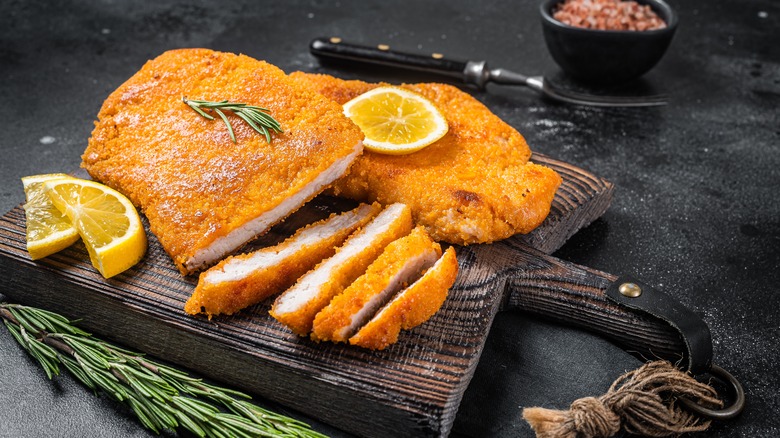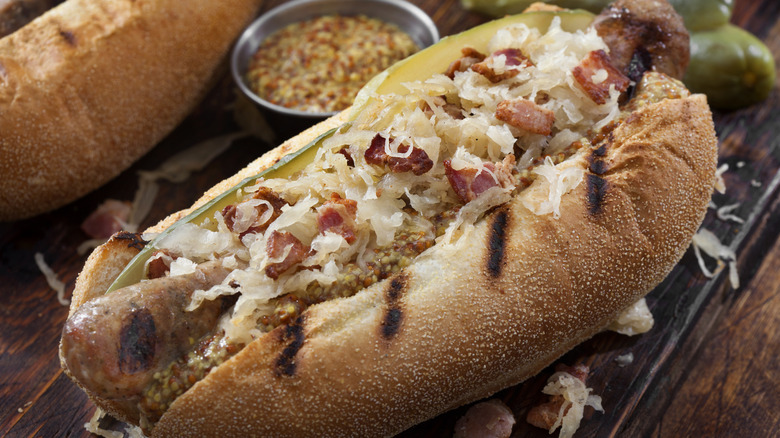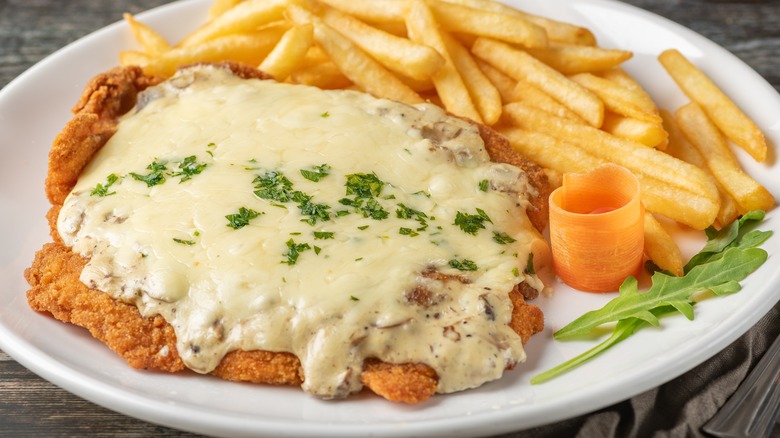What Sets Wiener Schnitzel Apart From Hot Dogs?
Hot dogs are a summertime tradition, hitting grills across the United States. It's common to hear the word "wiener" in reference to hot dogs throughout the season. When paired with the word "schnitzel," though, it becomes a thin, breaded cutlet made from veal, which is totally unrelated to American frankfurters — or the hot dog-slinging fast food chain.
Among Americans, though, the confusion between wiener schnitzel and hot dogs might partially be because of Wienershnitzel, which only made schnitzel sandwiches for a limited time in 2017. However, the chain's name came from a haphazard suggestion to founder John Galardi — pulled straight from a random cookbook — and it just stuck in his mind like he wanted his company to stick in customers' minds. Neither made of veal nor breaded and fried, Galardi simply thought of it as catchy enough to make his business stand apart and thus be a success.
The German translation of "wiener schnitzel" is "Viennese cutlet," an Austrian tradition that's protected by law — veal must be used to make this delicate and tender dish. Otherwise, restaurants and the like can't label it "wiener schnitzel."
History of wiener schnitzel versus hot dogs
The exact origin of wiener schnitzel has yet to be proven, but the most common legend is that an Austrian field marshal returned home in the 1850s from Italian territories with a cotoletta alla milanese recipe. The national dish was born from his cooks' own version of the recipe. However, breaded meats were already popular in Austria, and the first documentation of "wiener" was in an 1831 cookbook. Then, crediting the country with creating the veal cutlet came in the 1900s as part of a movement to protect certain dishes and differentiate wiener schnitzel from other nations' breaded meats.
Hot dogs have a few possible origins too but are likely based on a European sausage that immigrants brought with them. It was a Jewish baker from Frankfurt, Charles Feltman, who is often credited as being the first to sell sausages from a Coney Island wagon alongside milk rolls and sauerkraut in the 1860s. Even the origin of the name "hot dog" isn't certain, but the first print of it was in 1890s college newspapers. Then, after working for Feltman, a Jewish immigrant from Poland, Nathan Handwerker, opened a small hot dog stand at Surf and Stillwell — which evolved into the Nathan's Famous Hot Dogs that Americans still love today.
Variations of traditional wiener schnitzel
Austrians generally make schnitzel with pork (schweine schnitzel) rather than veal because pork is simply more common. Although less common in Austria, German restaurants make other kinds of schnitzels too, such as turkey (puten schnitzel) and chicken (hähnchen schnitzel), using similar preparation and cooking techniques. For a veggie version, you can also make an eggplant schnitzel.
According to the Austrian culinary code, the veal for traditional wiener schnitzel must have an egg wash, use flour and breadcrumbs, and then be fried. However, chefs and at-home cooks have made alterations based on their own preferences. For instance, they may use instant mashed potatoes for pork schnitzel rather than breadcrumbs or use an air fryer rather than a skillet.
Also, the variations aren't limited to the schnitzel itself and extend to the sides and sauces served alongside it. Traditional wiener schnitzel is frequently served with a lemon wedge to squeeze over the cutlet, buttered potatoes or potato salad, and some lingonberry jam.
However, it's always fun to get creative. Some different complementary sides include sauteed green beans, wild rice pilaf, and Tuscan mushrooms, but you can also turn tradition into novelty with carrot fries, radish chips, or even fried pickles. For sauces, pick something creamy but with enough bite to cut through the breading, like a mustard cream or cheese fondue. You could even put a piece of schnitzel in a biscuit with bratwurst gravy.



